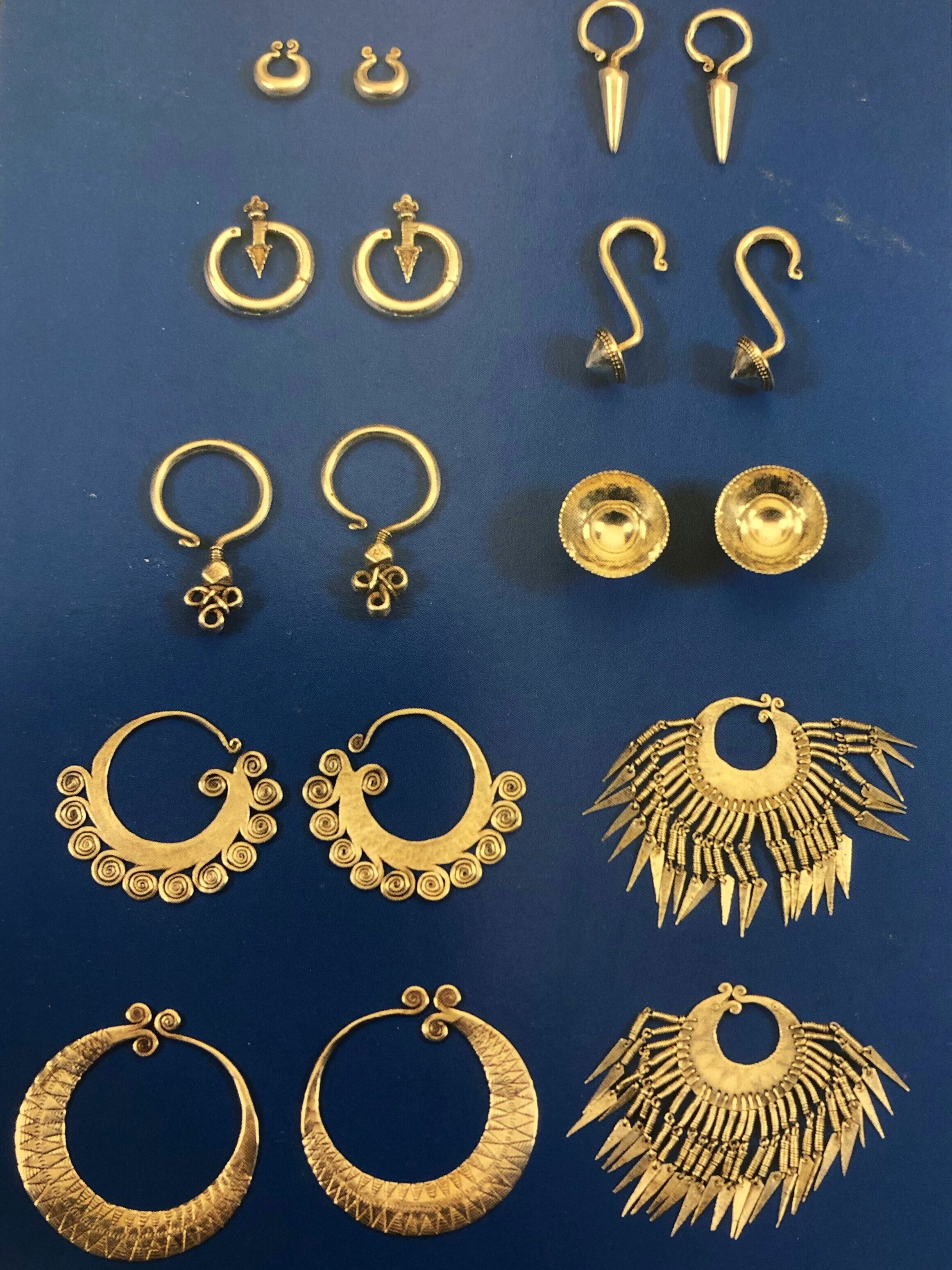Where and when do hoops originate?
The symbolism of jewellery
Jewellery has been for many civilizations the answer to a profound need for self-adornment and, consequently, is one of the oldest forms of decorative art. For the past ten thousand years, its history can be traced from the centres of the earliest known civilisations in Mesopotamia and Egypt to its universality in modern times. This panoramic survey of personal jewellery highlights both the inventiveness of goldsmiths imagination and, at the same time, the basic, almost primitive qualities that remain consistent factors, throughout the long story.
The recognition of the intrinsic beauty of certain materials and minerals, especially gold and silver, has led to their constant use in totally unconnected civilisations separated by vast barriers of time and space. That these materials were from the earliest times fashioned to beautify the human form is beyond doubt.
Body decoration is a timeless social indicator. It summarizes the wearer’s status and life history. It indicates a person’s tribal affiliation and describes the stages of his or her life. A certain kind of earring might be worn only by married women, and so on for girls, mothers, and widows.
The complex of signals that are encoded in personal ornamentation constitutes a kind of visual language. Such embellishment communicates many different kinds of information that ethnic groups rely upon for purposes of self-identification and mutual recognition.
The symbolism of hoops
The hoop earrings are a strong representation of the circle of life. They represent the notions of totality, wholeness, original perfection, the Self, the infinite, eternity, timelessness, all cyclic movement. It implies an idea of progress and symbolizes the perpetual motion of everything that flows. It also stands for enlightenment, perfection, strength, unity and power.
According to archaeological research, hoop earrings were discovered in different parts of the world dating many centuries ago, the oldest being the 8th century BC. These findings were also located in diverse locations of the world like Mesopotamia, Egypt, Europe, Russia, India, America to name just a few.
Below photos and descriptions show some of those findings and express the variations in shape, material, and symbolism.
Hoop earrings from Mesopotamia. Eighth/seventh century BC. Silver from the Vorderasiatisches Museum.
Fourteen silver earrings of the same type, which are not likely to have been worn all at the same time, were added to a Neo-Assyrian burial in a tub shaped sarcophagus. The six examples shown here have the typical shape of a horizontal crescent that, in each case, has a conical pendant centrally soldered to it.
Pair of hoop earrings from Egypt. Sixth/seventh century. Silver from the Skulpturensammlung und Museum fur Byzantinische Kunst.
The form and imagery of the hoop earrings are typical of the late antique period. In the lower part, below an ornamental border with variously twisted bands, two birds face one another and flank rings that are arranged into a triangle.
Hoop earrings from Egypt. Sixth/seventh century. Gold and pearl from the Museum fur Islamische Kunst.
From the sixth century on, this type of earring form was common not just in Egypt, but in the entire eastern Mediterranean region. While the pair of birds and the cross motifs point to Christian influences, the ornamental decor reveals the preference for nonfigurative imagery in the Islamic period.
Hoop earrings with animal head finials from Egypt. Third century BC. Gold, emerald, sardonyx, carnelian earrings from the Antikensammlung.
In the Hellenistic period, earrings with animal head finials - lion, lynx, dolphin, antelope - came into fashion. For greater effect, coloured stone beads were added to them, most often red garnets, green emeralds, and sometimes beads out of banded sardonyx.
A group of Egyptian hoop earrings. 1500-1200 BC.
The leech-shaped hoop earring was made from a piece of sheet electrum, folded over a shaped core masked by wire notched to imitate beading.
Cast bronze hoop earrings. 4th century BC from Pleurs (Marne, France).
A type of hoop earring worn by high ranking women in Champagne in the Early La Tene Period. The hoop is made in two pieces; a detachable segment can be removed by forcing open the hoop. This section is held in place by a mortise-and-tenon joint at each end.
Group of Kiev Russian silver jewellery. 12th-13th century.
The jewellery is part of a hoard discovered in 1906 in the street of the Three Saints, Kiev (Ukraine), and may be associated with others of similar composition from the city, buried perhaps under threat of the Tartar invasions from the 1230’s. Nielloed motifs of interlaced griffins and geometric patterns occur on the head-dress pendants, known as kolts, while the silver beads on other such pendants are heavily enriched with filigree and granulation.
Hoop earrings from Sudan (Nubian desert). Gold.
Resembling Byzantine earrings, these ornaments are worn by herders’ wives. As in other pastoral societies, wealth in livestock is a source of prestige.
Hoop earring from India. 18th/19th century. Gold, precious stones and enamel.
This is an example of kundan work, a method of gem-setting consisting of inserting gold foil between the stone and its mount. the backing adds brilliance while helping to conceal the irregular cut of the stone.
Hoop earrings from Himachal Pradesh, India. Gold. 1st half of 20th Century.
Round twisted loop ending in a closed spiral.
Earrings, most of them being hoops from Thailand, Burma, Laos. 1st half 20th century.
There are different findings in various parts of the world throughout history. They represent only just a few examples to show how jewellery and hoops have been present in civilizations for many centuries already. And how the symbolism of the hoop remains until the present day.
Love,
Nena
Most of the images and references you see in this post are from the following books and research materials:
“The splendor of ethnic jewelry: from the Colette and Jean-Pierre Ghysels Collection” by France Borel.
“25.000 years of jewelry: from the collections of the Staatliche Museen Zu Berlin” by Maren Elchhorn Johannsen.
“7.000 years of jewelry” by Hugh Tait.











